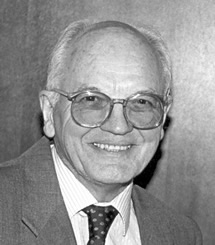

|

|
IN MEMORIAM
Chester T. O’Konski
Professor of Chemistry, Emeritus
Berkeley
1921 – 2006
Chester T. O’Konski died at his home in El Cerrito, California, on August 2, 2006. He was a member of the faculty for 43 years at the University of California, Berkeley.
He was born on May 12, 1921 on his parents’ dairy farm in Kewaunee, Wisconsin. As an undergraduate, he attended the University of Wisconsin – Madison. Like many students during that period, he saw his education interrupted by World War II. After obtaining a B.S. in chemistry in 1942, he was selected to work as a member of a secret team which was sent to Florida and then to the jungles of Panama in 1944 to study technical aspects of gas warfare in preparation for possible need for such knowledge in the Pacific Theater. O’Konski was instrumental in the design of the first aerosol particle counter, together with a team of chemists from the California Institute of Technology. Several Berkeley faculty members were also involved in this work, and so he established a Berkeley connection even before he finished his doctoral work.
When the war effort ended, O’Konski received an M.S. in physical chemistry from Northwestern University in 1946. Two years later, a year before Northwestern granted him his Ph.D. in physical chemistry, he was hired as an instructor in the Department of Chemistry at Berkeley. His Northwestern publications, with Frank T. Gucker, concerned the development of photoelectric counting for aerosols. A coauthor on one paper was James N. Pitts Jr. who became the first chairman of the Department of Chemistry at the University of California, Riverside.
In his 43 years on the faculty of the Department of Chemistry, O’Konski employed many different methods to study the properties of large molecules. He was among the first physical and polymer chemists to apply high electric fields to solutions of biological materials in an effort to measure the asymmetric properties resulting from the field. The technique allowed examination of molecules as they exist in their natural state in solution, and it yielded new information about the size, structure, and optical and physical properties of macromolecules.
O’Konski was also a pioneer in the use of nuclear quadrupole spectroscopy, a technique used to examine how nuclei in the atoms of a molecule react to chemical bonding. This technique provides information about the electrons involved in bonding, and he worked out theoretical calculations on chemical bonding in certain molecules to help explain his results. He was particularly interested in using N-14, which is naturally present, in ammonia and other molecules.
In 1950, after two years as an instructor, O’Konski became an assistant professor, and then was made a full professor in 1960. He remained active in the Department of Chemistry until his retirement in 1991. He wrote nearly 100 scientific publications.
He was full of ideas, so that incoming graduate students found him attractive; and over the years he was able to attract some extremely capable students. One of them said he was “a personable and engaging man, very bright and energetic.” Not always easy to work with, he produced a remarkably strong group of students who graduated with Ph.D. degrees and have had well established science careers.
His early work in the optical properties of biological molecules and viruses, particularly the tobacco mosaic virus, won O’Konski a number of awards. In 1955, he received a Guggenheim fellowship to Leiden University in the Netherlands. In 1960, he held the position in the Department of Chemistry as a Miller Professor with Berkeley’s Miller Institute for Basic Research in Science. In 1970 he was named a Nobel guest professor at Uppsala University in Sweden.
Citing O’Konski's research that demonstrated the feasibility of using electric field-induced double refraction (“birefringence”) to study the electrical properties and structures of macromolecules in solution, the International Committee for Molecular Electro-optics awarded him the J. Kerr Medal in 1991. His last scientific work was a paper on the history of the light-scattering measurements done in the 1940s, presented in March 2000 at the San Francisco meeting of the American Chemical Society.
He is survived by his daughter, Holly Austin, of Crescent City, California; his three sons, Tim of Palo Alto, California, Mark, of Fort Myers, Florida, and Brian of Washington, D.C.; and five grandchildren.
John E. Hearst
Rollie J. Myers